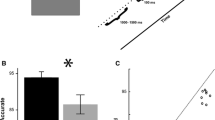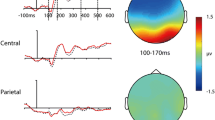Abstract
Contextual information allows the human brain to make predictions about the identity of objects that might be seen and irregularities between an object and its background slow down perception and identification processes. Bar and colleagues modeled the mechanisms underlying this beneficial effect suggesting that the brain stocks information about the statistical regularities of object and scene co-occurrence. Their model suggests that these recurring regularities could be conceptualized along a continuum in which the probability of seeing an object within a given scene can be high (probable condition), moderate (improbable condition) or null (impossible condition). In the present experiment, we propose to disentangle the electrophysiological correlates of these context effects by directly comparing object–scene pairs found along this continuum. We recorded the event-related potentials of 30 healthy participants (18–34 years old) and analyzed their brain activity in three time windows associated with context effects. We observed anterior negativities between 250 and 500 ms after object onset for the improbable and impossible conditions (improbable more negative than impossible) compared to the probable condition as well as a parieto-occipital positivity (improbable more positive than impossible). The brain may use different processing pathways to identify objects depending on whether the probability of co-occurrence with the scene is moderate (rely more on top-down effects) or null (rely more on bottom-up influences). The posterior positivity could index error monitoring aimed to ensure that no false information is integrated into mental representations of the world.




Similar content being viewed by others
References
Aminoff E, Gronau N, Bar M (2007) The parahippocampal cortex mediates spatial and nonspatial associations. Cereb Cortex 17:1493–1503. doi:10.1093/cercor/bhl078
Aminoff EM, Kveraga K, Bar M (2013) The role of the parahippocampal cortex in cognition. Trends Cogn Sci 17:379–390. doi:10.1016/j.tics.2013.06.009
Balconi M, Vitaloni S (2014) N400 effect when a semantic anomaly is detected in action representation. a source localization analysis. J Clin Neurophysiol 31:58–64
Bar M (2004) Visual objects in context. Nat Rev Neurosci 5:617–629. doi:10.1038/nrn1476
Bar M, Aminoff E (2003) Cortical analysis of visual context. Neuron 38:347–358
Barenholtz E (2014) Quantifying the role of context in visual object recognition. Vis Cogn 22:30–56. doi:10.1080/13506285.2013.865694
Biederman I, Mezzanotte RJ, Rabinowitz JC (1982) Scene perception: detecting and judging objects undergoing relational violations. Cogn Psychol 14:143–177
Brodeur MB, Dionne-Dostie E, Montreuil T, Lepage M (2010) The Bank of Standardized Stimuli (BOSS), a new set of 480 normative photos of objects to be used as visual stimuli in cognitive research. PLoS One 5:e10773. doi:10.1371/journal.pone.0010773
Brodeur MB, Guerard K, Bouras M (2014) Bank of Standardized Stimuli (BOSS) phase II: 930 new normative photos. PLoS One 9:e106953. doi:10.1371/journal.pone.0106953
Castelhano MS, Henderson JM (2008) The influence of color on the perception of scene gist. J Exp Psychol Hum Percept Perform 34:660–675. doi:10.1037/0096-1523.34.3.660
Davenport JL, Potter MC (2004) Scene consistency in object and background perception. Psychol Sci 15:559–564. doi:10.1111/j.0956-7976.2004.00719.x
Demiral SB, Malcolm GL, Henderson JM (2012) ERP correlates of spatially incongruent object identification during scene viewing: contextual expectancy versus simultaneous processing. Neuropsychologia 50:1271–1285. doi:10.1016/j.neuropsychologia.2012.02.011
Donchin E, Coles MG (1988) Is the P300 component a manifestation of context updating? Behav Brain Sci 11:357–374. doi:10.1017/S0140525X00058027
Dyck M, Brodeur MB (2015) ERP evidence for the influence of scene context on the recognition of ambiguous and unambiguous objects. Neuropsychologia 72:43–51. doi:10.1016/j.neuropsychologia.2015.04.023
Federmeier KD, Kutas M (2001) Meaning and modality: influences of context, semantic memory organization, and perceptual predictability on picture processing. J Exp Psychol Learn Mem Cogn 27:202–224
Fenske MJ, Aminoff E, Gronau N, Bar M (2006) Chapter 1 Top–down facilitation of visual object recognition: object-based and context-based contributions. Prog Brain Res 155B:3–21
Ganis G, Kutas M (2003) An electrophysiological study of scene effects on object identification. Brain Res Cogn Brain Res 16:123–144
Gratton G, Coles MG, Donchin E (1983) A new method for off-line removal of ocular artifact. Electroencephalogr Clin Neurophysiol 55:468–484
Hock H, Gordon G, Whitehurst R (1974) Contextual relations: the influence of familiarity, physical plausibility, and belongingness. Percept Psychophys 16:4–8
Holms S (1979) A simple sequentially rejective multiple test procedure. Scand J Statist 6:65
Joubert OR, Fize D, Rousselet GA, Fabre-Thorpe M (2008) Early interference of context congruence on object processing in rapid visual categorization of natural scenes. J Vis. doi:10.1167/8.13.11
Kolk HH, Chwilla DJ, van Herten M, Oor PJ (2003) Structure and limited capacity in verbal working memory: a study with event-related potentials. Brain Lang 85:1–36
Levelt WJ (1983) Monitoring and self-repair in speech. Cognition 14:41–104
Mania K, Robinson A, Brandt KR (2005) The effect of memory schemas on object recognition in virtual environments. Presence 14:606–615
McPherson WB, Holcomb PJ (1999) An electrophysiological investigation of semantic priming with pictures of real objects. Psychophysiology 36:53–65
Mudrik L, Lamy D, Deouell LY (2010) ERP evidence for context congruity effects during simultaneous object-scene processing. Neuropsychologia 48:507–517. doi:10.1016/j.neuropsychologia.2009.10.011
Mudrik L, Shalgi S, Lamy D, Deouell LY (2014) Synchronous contextual irregularities affect early scene processing: replication and extension. Neuropsychologia 56:447–458. doi:10.1016/j.neuropsychologia.2014.02.020
Oliva A, Torralba A (2007) The role of context in object recognition. Trends Cogn Sci 11:520–527. doi:10.1016/j.tics.2007.09.009
Polich J (2007) Updating P300: an integrative theory of P3a and P3b. Clin Neurophysiol 118:2128–2148. doi:10.1016/j.clinph.2007.04.019
Sitnikova T, Kuperberg G, Holcomb PJ (2003) Semantic integration in videos of real-world events: an electrophysiological investigation. Psychophysiology 40:160–164
Sitnikova T, Holcomb PJ, Kiyonaga KA, Kuperberg GR (2008) Two neurocognitive mechanisms of semantic integration during the comprehension of visual real-world events. J Cogn Neurosci 20:2037–2057. doi:10.1162/jocn.2008.20143
Sun HM, Simon-Dack SL, Gordon RD, Teder WA (2011) Contextual influences on rapid object categorization in natural scenes. Brain Res 1398:40–54. doi:10.1016/j.brainres.2011.04.029
Trapp S, Bar M (2015) Prediction, context, and competition in visual recognition. Ann N Y Acad Sci 1339:190–198
Vissers CT, Chwilla DJ, Kolk HH (2006) Monitoring in language perception: the effect of misspellings of words in highly constrained sentences. Brain Res 1106:150–163. doi:10.1016/j.brainres.2006.05.012
Vissers CT, Chwilla DJ, Kolk HH (2007) The interplay of heuristics and parsing routines in sentence comprehension: evidence from ERPs and reaction times. Biol Psychol 75:8–18. doi:10.1016/j.biopsycho.2006.10.004
Vissers CT, Kolk HH, van de Meerendonk N, Chwilla DJ (2008) Monitoring in language perception: evidence from ERPs in a picture-sentence matching task. Neuropsychologia 46:967–982. doi:10.1016/j.neuropsychologia.2007.11.027
Vo ML, Henderson JM (2009) Does gravity matter? Effects of semantic and syntactic inconsistencies on the allocation of attention during scene perception. J Vis 9(24):21. doi:10.1167/9.3.24
Vo ML, Wolfe JM (2013) Differential electrophysiological signatures of semantic and syntactic scene processing. Psychol Sci 24:1816–1823. doi:10.1177/0956797613476955
Acknowledgements
We would like to thank all participants. We are also grateful to Dr. Boutheina Jemel for her help on visual analyses. This study was funded by the Natural Sciences and Engineering Research Council of Canada #388752-2012.
Author information
Authors and Affiliations
Corresponding author
Ethics declarations
Conflicts of interest
The authors declare that they have no conflict of interest.
Ethical approval
All procedures performed in studies involving human participants were in accordance with the ethical standards of the institutional and/or national research committee and with the 1964 Helsinki declaration and its later amendments or comparable ethical standards.
Electronic supplementary material
Below is the link to the electronic supplementary material.
Rights and permissions
About this article
Cite this article
Sauvé, G., Harmand, M., Vanni, L. et al. The probability of object–scene co-occurrence influences object identification processes. Exp Brain Res 235, 2167–2179 (2017). https://doi.org/10.1007/s00221-017-4955-y
Received:
Accepted:
Published:
Issue Date:
DOI: https://doi.org/10.1007/s00221-017-4955-y




